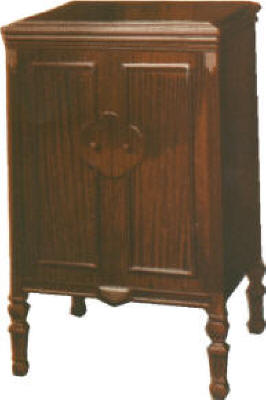
The Victor-Victrola Page
 VV
7-10 / VE 7-10
VV
7-10 / VE 7-10
RARITY: ¤¤¤ VALUE: ¤

 The
VV 7-10 was a "home entertainment center" pairing a Victor Orthophonic
(acoustic) phonograph with an RCA Radiola 16. The phonograph featured a
two-spring motor and a small "folded" (re-entrant) horn. As was the case with many radio
sets of that timeframe, the radio was
powered by a group of batteries that were mounted inside the cabinet. The
Radiola 16 was one of the first 'TRF' (Tuned Radio Frequency) sets that required
only a single knob for tuning, rather than the typical array of knobs that was
previously required to select a radio station. It also included newly-developed
tube designs which were far more reliable than previous versions. A large
mechanical-valve "switch" would change the routing from the radio's
electromagnetic driver or from the phonograph's tonearm directly to the horn's
"neck". Since the newly-developed paper-cone speaker, which provided better
sound (and eliminated the large mechanical switching valve) had become popular
by the end of 1927, the 7-10 was essentially obsolete when it was introduced.
The
VV 7-10 was a "home entertainment center" pairing a Victor Orthophonic
(acoustic) phonograph with an RCA Radiola 16. The phonograph featured a
two-spring motor and a small "folded" (re-entrant) horn. As was the case with many radio
sets of that timeframe, the radio was
powered by a group of batteries that were mounted inside the cabinet. The
Radiola 16 was one of the first 'TRF' (Tuned Radio Frequency) sets that required
only a single knob for tuning, rather than the typical array of knobs that was
previously required to select a radio station. It also included newly-developed
tube designs which were far more reliable than previous versions. A large
mechanical-valve "switch" would change the routing from the radio's
electromagnetic driver or from the phonograph's tonearm directly to the horn's
"neck". Since the newly-developed paper-cone speaker, which provided better
sound (and eliminated the large mechanical switching valve) had become popular
by the end of 1927, the 7-10 was essentially obsolete when it was introduced.
This Victrola could be ordered with either a spring powered phonograph (VV
7-10)
or with an electric motor option (VE 7-10). To clarify this
confusing terminology, the electric-motor designation refers to the phonograph
motor only; in both models the radio was battery powered. VE versions eliminated
the need to hand-wind the phonograph motor.
The 7-10 was
introduced in the autumn of 1927, and production was abruptly discontinued
within a few months when more
advanced (and lower cost) radio/phono systems became available on the market. The cabinet
had a rather plain "boxy" design with a mahogany veneer. It sold new for $275.00, which equates
to approximately $4,100.00 in today's money. The electric motor was a $35.00
option.
Approximately 5,900 VV 7-10 consoles were
produced in late 1927, but less than 300 electric-powered (VE 7-10) versions
were made. Since radio and electronic technology was developing so rapidly
in the mid-1920's, the 7-10 became obsolete very quickly, and it is likely that many were sold at
discount in 1928.
While the 7-10 is a relatively rare model, the high cost of restoration of these early electronic sets
limits the interest of many collectors today.
The current survival database shows the earliest existent VV 7-10 to be s/n 601 and the latest to be s/n 4995
No VE 7-10 models have been logged at this time
Do you own a Victrola 7-10? Please take a moment and enter some basic information about your machine into the collector's database by clicking here. No personal information is required.